“All Women are all Goddesses. But since we don’t behave like Goddesses, we’re not recognized. And when we are not recognized, we end up self-presenting too much…. Advertising. The Goddess never advertises.” – From The Book of Jane.
On November 21 Antero Alli, a California-based experimental filmmaker, will be screening his latest feature film, The Book of Jane, at the Berkeley Arts Festival. Filmed in the Bay Area with an all-local cast, The Book of Jane is Alli’s 11th feature film which follows a long list of productions that coincide with Alli’s personal journey as an artist.
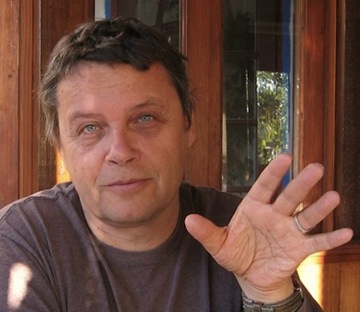
Director Antero Alli
Born in Finland, Alli began filmmaking in 1992 after the tragic death of his daughter. He says that this trauma “gifted him with vision” which turned into an interest in experimental filmmaking. Before going behind the camera, Alli built a successful career as a published writer, professional astrologer, and as the founder and director of a Paratheatrical Research Theater. He draws from all these experiences in creating his films.
While Alli does not identify as a Pagan, his films often explore mystical, Pagan or Occult themes. For example, in 2000 he produced a film called Tragos, which tells the story of modern Pagans being hunted-down by a fundamentalist Christian attorney. In other films, he touches on or has characters that embody similar themes such as Shamanism, Ceremonial Magick, and dreamworking.
The Book of Jane is no exception. The film’s very simple narrative includes a complex thematic that spins around the idea and need for Goddess worship. Jane, aptly named for her anonymity as a homeless woman, wanders a California university campus by day and sleeps under a bridge at night. One day Alice, a Comparative Religions Professor, happens upon Jane while sitting on a park bench. This chance meeting begins a series of interactions that lead to a spiritual transformation for both women.
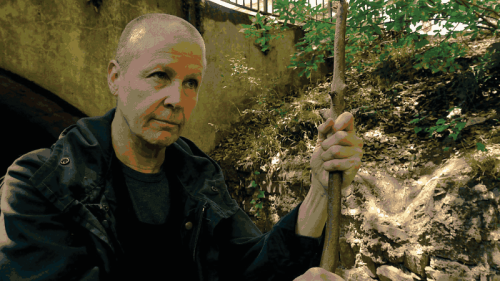
Luna Olcott as Jane
Right from the beginning it is obvious that Alli is expressing his own philosophical, theoretic and theological ideas through Jane. In an online essay, he comments that he was “initially going to portray” “Jane” as “John” but he felt actress Luna Olcott fit the role far better. This was a positive, critical choice. With an all woman cast, the film embodied the concept of natural transformative femininity. With a man in that role, the dialog on patriarchy and Goddess worship would have seemed more like a disconnected, insincere lecture.
As an experimental film, The Book of Jane is more of a journey and an experience than classic narrative storytelling. This type of cinema is more commonly called “avant garde,” “art house,” or “underground” cinema. This simply means that movie does not conform to the language of mainstream Hollywood. While that may not sound like a whole lot, it is. There are no unwritten rules in experimental cinema. It is an expressive art form created by an artist for the sake of the art alone.
In The Book of Jane, Alli chose some interesting techniques to create what film theorists called “distanciation.” In other words, he employed technical devices that prevent the viewer, us, from becoming hypnotized by the film’s world. For example, Alli breaks his film into chapters with titles in classic Brechtian-syle. He also uses voice-over as Jane’s thoughts which, at times, serves more as a quasi-lecture to the viewers. These disruptive elements constantly push us out of the film and remind us that we are just watching a movie.
There are several touching moments where Alli actually allows us to enter the film with his characters. There are two scenes in which Jane speaks to the old doll – the only connection that she has left to her deceased daughter. In these quiet moments, Alli’s structure falls away and we are drawn into Jane’s years of pain. Similarly, the film spends a lot of time following Jane around her world. When the voice-over stops, the journey becomes hypnotic as we are drawn into her nomadic lifestyle.
Some of the most captivating points in the film involve dream sequences. From the opening to the final shots, the crow is a power symbol representing the Morrigan as the guide to powerful transformation. In Jane’s dream sequences and visions, she is often visited by the Morrigan, who is portrayed by Morpheus Ravenna.
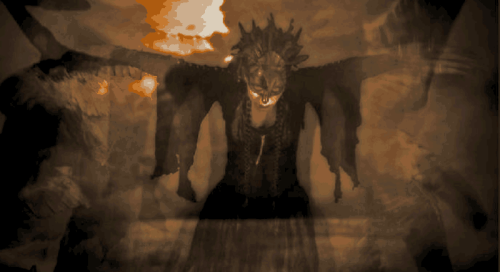
Morpheus Ravenna as the Morrigan
When Alli saw video clips of Morpheus’ devotional dances to the Morrigan, he was thrilled to have her on-board. She says,
My long history of working with devotional performance and ritual drama gave me some skills to work with… It was a natural creative step to make…This has been part of my ongoing and always-deepening connection with the Morrigan. It was interesting to be given this challenge of taking a story about these individual women’s lives and weave that into my devotional dance work.
At first Alli had called this figure a bird goddess. After speaking with Morpheus, he adapted the work to include the Morrigan. Out of that came the crow symbolism as well as the costuming and imagery for these strikingly haunting, but beautiful dream sequences. Morpheus says,
One of the things I liked a lot about the way we portrayed Her is that we were able to express a bit of Her compassionate side, which is something I feel gets often overlooked in popular portrayals of the Morrigan that tend to focus on Her aspect as a fierce battle Goddess.
The film focuses a great deal on Goddess mythology – in both symbolic and plot form. At times, the film stops to lecture on the subject, through dialog and voice-over. These college-style lectures are somewhat distracting and prevent us from enjoying what the film is doing best – taking us on a journey. The Book of Jane encapsulates the Goddess experience through its symbolism, narrative and the imagery. For example, the main three characters are meant to be the Maiden, Mother and Crone. The film doesn’t need tell us because it already has shown us.
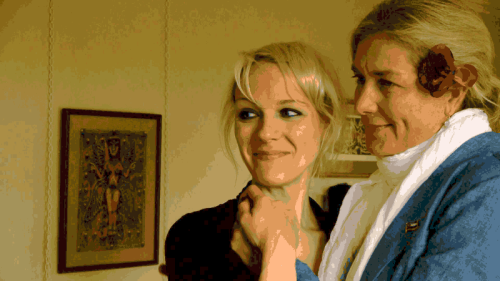
Alice with her partner, Collette
Similarly, the weakest parts of this film were the scenes with significant character interaction. While they are necessary to propel the plot, these segments often contained weak or overly academic dialog. The actors’ delivery was inconsistent – sometimes natural and sometimes forced. In addition, Alli often shot these scenes in close-up using a very rhythmic shot-reverse-shot structure.This can have a dizzying effect similar to watching a tennis match.
Despite these weak points, the dialog did not detract from Alli’s goal. He writes:
I wanted to show how shocks and traumas can sometimes act as evolutionary triggers that transform our lives for the better, even though by outward appearances it may seem otherwise.
This film is not about Goddess worship or the presentation of a feminist world-view. It is a journey about personal transformation and the process of letting go. The aspects of the Goddess presented are just detailed reflections that make this transformative journey a powerful and natural one for women.
As I mentioned earlier, the viewer experiences a frustrating push and pull that allows limited connectivity to the characters. We are objective observers distanced from the inner sanctum of the film. However we are paid off in the last scene. When Alice accepts transformation and let’s go, Alli sets us free through music, dance and imagery. The feel of the scene mirrors the emotional state and spiritual arch of the main characters.
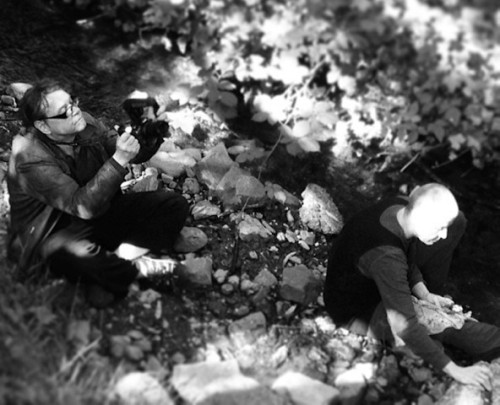
Alli filming Olcott by the river
Because The Book of Jane is a journey, I don’t want to reveal too much about the plot or narrative. Overall, it is a very interesting film with a powerful theme that lingers in the mind. Although directed by a man, it will be especially poignant for women as it attempts to express and free the feminine transformative process.
For more information on Antero Alli’s films, you can go to his production company’s website Vertical Pool. He has posted a detailed filmography with a listing of all the possible ways of viewing his films including the The Book of Jane, which will premier at the Berkeley Film Festival on November 21.
The Wild Hunt is not responsible for links to external content.
To join a conversation on this post:
Visit our The Wild Hunt subreddit! Point your favorite browser to https://www.reddit.com/r/The_Wild_Hunt_News/, then click “JOIN”. Make sure to click the bell, too, to be notified of new articles posted to our subreddit.
I remember seeing a preview-type YouTube of this film. Look forward to seeing the entire thing.
I saw the trailer for that before, and was only mildly interested. I know it’s still a good and necessary thing for some people, but I feel I’ve been lecture to at length about “natural transformative femininity” far too many times over the years. Having a male character do it would simply have been intolerable, flat-out mansplaining. I’m pretty uncomfortable with a male writer and filmmaker doing it, too. If I don’t need other women telling me about “natural transformative femininity,” I certainly don’t need a man telling me about it. (Might be interested in another conversation — not a lecture — with some agender, genderqueer, or various sorts of nonbinary people about the value THEY find in the concept. Sometimes those are fascinating.)
But I’m sure other people will get something out of this film, and I hope they do.
I found Ms. Greene’s review of my film both judicious and thoughtful but she misinterpreted homeless Jane’s ‘lecturing tone & content’ which reflects Jane’s early academic history mixed with her current psychic state from the meds she’s taking. There are also no crows in this film nor any reference to crows; they are ravens (a small quibble but symbolically relevant).
Fourth post! Whoo! Commenting within hours of this post arriving –a rare treat for myself!